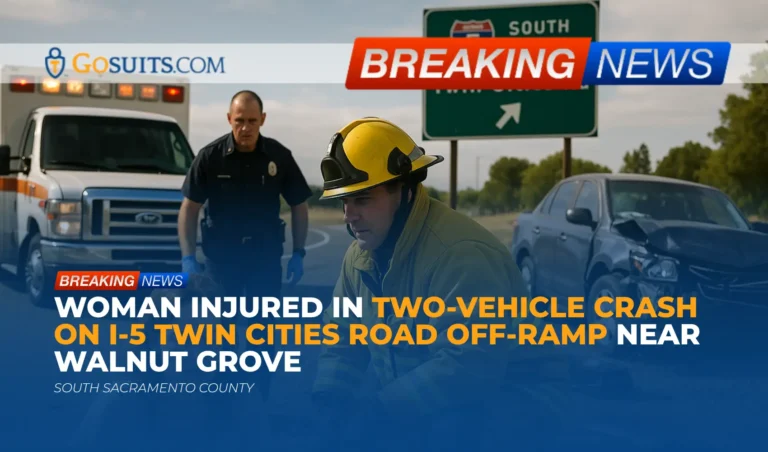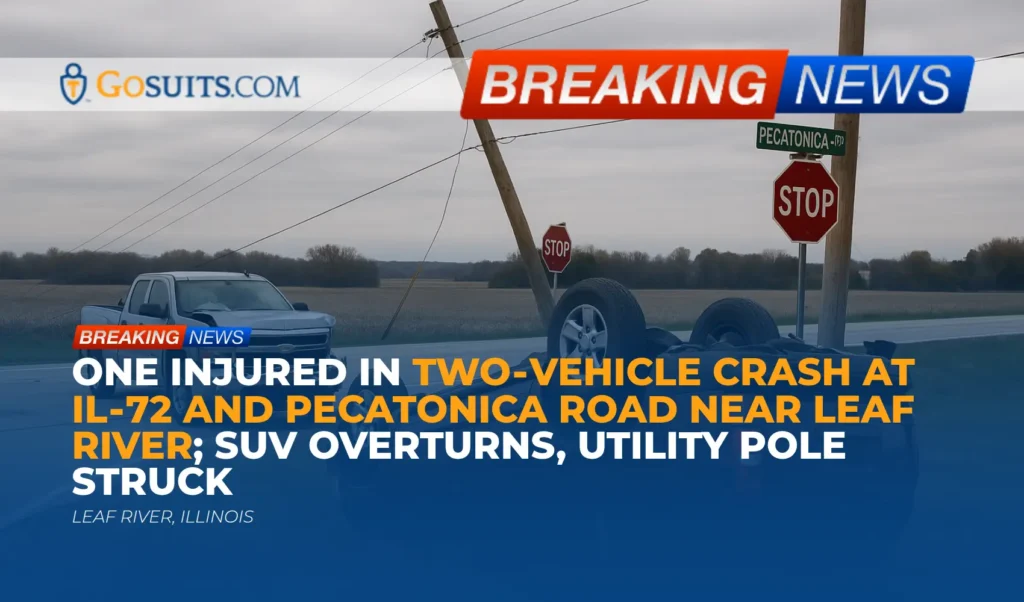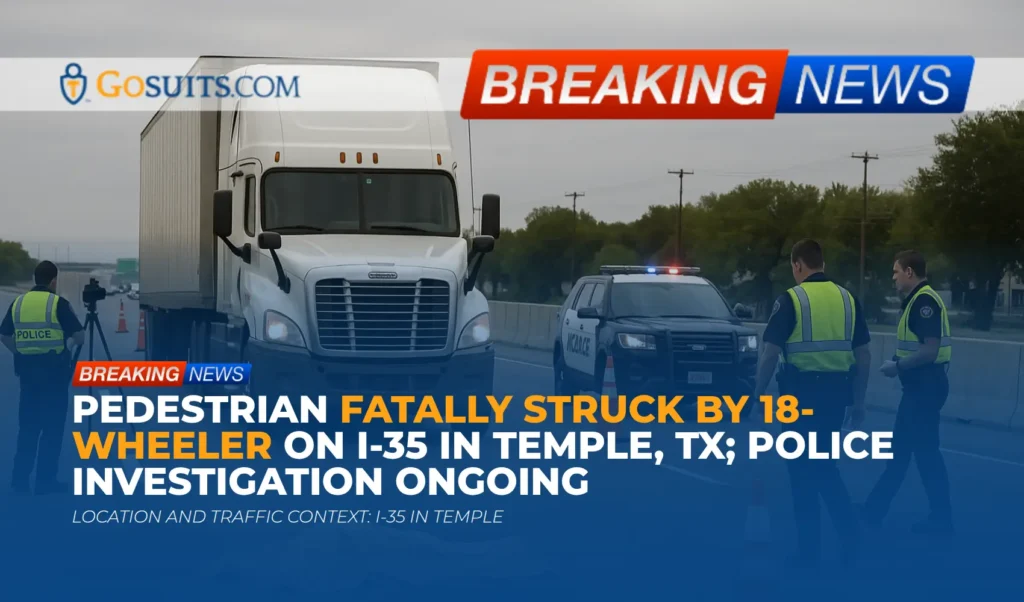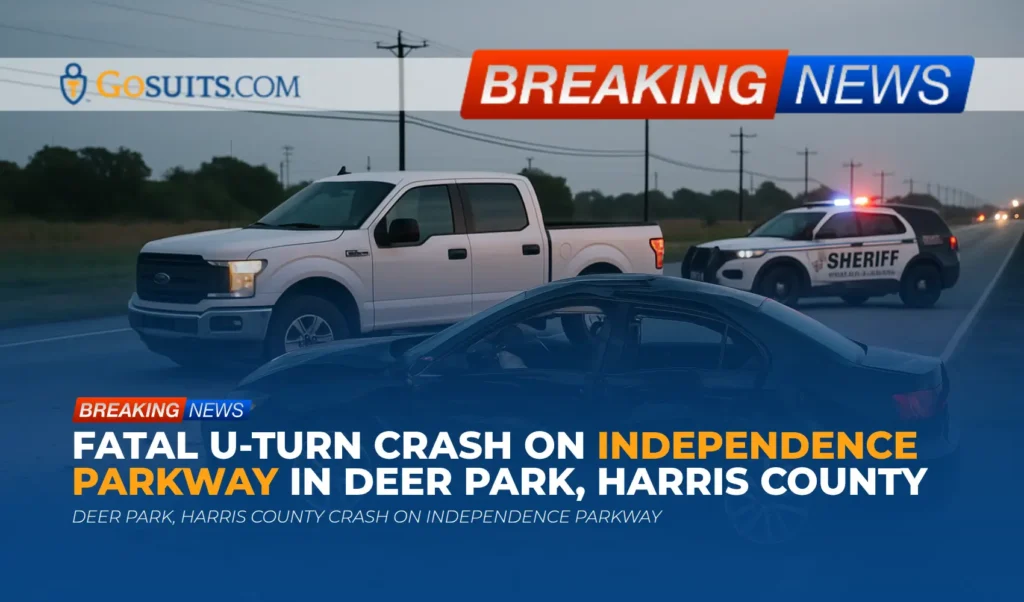- What we know about the Twin Cities Road off-ramp crash
- Where it happened and why off-ramps can be hazardous
- What investigators typically examine after a two-vehicle crash
- Rights and practical steps for people affected
- How to obtain official records and documents
- Insurance coverage and claims in California
- Potential civil liability considerations
- Medical care, billing protections, and documentation
- Preserving evidence and protecting your claim
- Community roadway safety notes for the I-5/Twin Cities Road area
- Act now: why timing matters and what to do next
- Commentary from Gosuits Walnut Grove, California Personal Injury Attorney
What we know about the Twin Cities Road off-ramp crash
According to California Highway Patrol information referenced by regional news alerts, a two-vehicle collision was reported on Tuesday morning in south Sacramento County near Walnut Grove. Emergency medical services were dispatched at approximately 7:19 a.m. to the southbound Interstate 5 off-ramp for Twin Cities Road. A woman sustained injuries and was transported to a nearby hospital for treatment. The cause of the crash was not immediately clear at the time of the dispatch reports.
At this early stage, details such as the precise mechanics of impact, pre-impact driving behavior, lighting and traffic conditions, or whether any traffic control devices were involved have not been made public. CHP typically leads on-scene response and investigation for crashes on interstates and their ramps.
Where it happened and why off-ramps can be hazardous
The crash occurred at the southbound I-5 off-ramp to Twin Cities Road, near Walnut Grove in south Sacramento County. Off-ramps and ramp terminals are transition zones: vehicles decelerate from freeway speeds, blend with cross traffic, and navigate signage and lane drops in a relatively short distance. Even when conditions are dry and clear, drivers must adapt quickly.
Nationwide safety data consistently highlight the risks associated with speed adaptation and following distance during transitions from high-speed roadways. Risky driving behaviors such as speeding and distraction are significant contributors to crashes in general, and the risks can be magnified where traffic merges and diverges. For background on the safety risks of speeding and inattentive driving, see NHTSA’s speeding overview and NHTSA’s distracted driving resource.
While the specific cause here is unknown, the nature of off-ramps underscores the importance of safe following distances, prudent speeds, and careful observation of traffic conditions.
What investigators typically examine after a two-vehicle crash
When CHP investigates a collision, typical areas of focus include:
- Pre-crash behavior and vehicle positioning: Lane usage, merging or diverging maneuvers, turn movements, and whether either vehicle made a sudden stop or lane change.
- Speed and following distance: Whether drivers were traveling at a safe speed for the conditions and maintaining sufficient following space.
- Traffic control and signage: Presence and visibility of signs, lane markings, and any temporary control related to maintenance or construction.
- Roadway and environmental conditions: Lighting, weather, road surface conditions, and sight distance on the ramp and at the ramp terminal.
- Witness accounts and physical evidence: Skid marks, vehicle damage profiles, debris fields, and statements from involved parties and witnesses.
- Impairment or distraction indicators: Signs of impairment, cell phone use, or other distractions, if applicable.
- Vehicle condition: Possible mechanical issues such as brake or tire problems that might have contributed.
CHP documents these findings in a Traffic Collision Report. Parties listed in the report can request a copy for their records and for insurance purposes. Details on how to request CHP reports are provided below.
Rights and practical steps for people affected
Crashes cause sudden disruption, pain, and uncertainty. Taking a few grounded steps can help protect well-being and preserve important information:
- Prioritize medical care: Accept emergency transport if recommended. Some injuries, including concussion or internal injuries, may not be obvious immediately. Follow-up care creates a record of your symptoms and treatment.
- Document what you can, safely: Photos of vehicle positions, damage, skid marks, the ramp area, and any visible injuries can help later. If safe, note the weather, lighting, and any construction or signage near the off-ramp.
- Identify witnesses: Obtain names and contact information for people who saw the collision or its aftermath.
- Request the report number: If possible, note the CHP incident or report number at the scene. If you do not have it, you can often find helpful information through the CHP incident page and by contacting the local CHP office.
- Consider legal guidance early: Before speaking with any insurance company (including your own) about fault or giving a recorded statement, consider consulting a personal injury attorney for a free consultation to understand your rights. Statements can be used later in ways that may affect your claim.
- Meet required filings: California requires the DMV Form SR-1 to be filed within 10 days if anyone was injured or property damage exceeded the threshold, even if a law enforcement report was made. See the DMV’s accident reporting requirements at dmv.ca.gov.
How to obtain official records and documents
Getting the right documents can help with medical coordination and any insurance or civil claim. The following are key sources and how to access them:
California Highway Patrol Traffic Collision Report
CHP is generally the record-keeping agency for freeway and off-ramp collisions. To request a collision report, use CHP Form 190 and follow the CHP process. Instructions are at CHP Collision Report Request.
If you do not know which local area office handled the collision, you can find contact information via CHP Find an Office. To monitor incident activity near the time of the crash, the public CHP Incident Page can be useful for locating incident numbers and responding units.
Emergency medical records
Hospitals and EMS providers maintain records of evaluation and treatment. Patients generally have rights to access their health information under federal law. The U.S. Department of Health and Human Services outlines these rights here: HHS HIPAA rights. Request copies of emergency department records, imaging, discharge instructions, and EMS patient care reports. Keep billing statements and explanations of benefits.
Coroner and autopsy records, if there is a fatality
In this incident, initial reports indicate injury but no fatality. In cases involving loss of life in Sacramento County, the Sacramento County Coroner’s Office oversees death investigations and maintains related records. Families can find information about procedures and requests at the official Coroner site: coroner.saccounty.gov.

Public records requests
Some materials, like 911 audio or certain agency communications, may be requested under the California Public Records Act. The California Attorney General provides guidance about public access to government records at oag.ca.gov/open-government.
Insurance coverage and claims in California
California is an at-fault state for auto collisions. In general, the at-fault driver’s liability coverage may address bodily injury and property damage, subject to policy limits and defenses. Common coverages include:
- Bodily Injury Liability: Pays for injuries the at-fault driver causes to others, up to policy limits.
- Property Damage Liability: Pays for damage to someone else’s vehicle or property caused by the at-fault driver.
- Medical Payments (Med-Pay): Optional, can pay medical bills for the insured and passengers regardless of fault, up to limits.
- Uninsured/Underinsured Motorist (UM/UIM): Applies if the at-fault driver lacks sufficient insurance. It can cover bodily injury and, in some policies, property damage.
- Collision and Comprehensive: First-party coverages that can repair or replace your vehicle regardless of fault (collision) or for non-crash events (comprehensive).
The California Department of Insurance offers consumer guides on auto coverages and claims at insurance.ca.gov. California’s Fair Claims Settlement Practices Regulations set standards for claim handling; see the Department’s overview at insurance.ca.gov.
Before reporting a claim or giving a recorded statement, consider speaking with a personal injury attorney for a free consultation to understand your rights. Communications with insurers can be used later in the claim.
Potential civil liability considerations
The law requires all drivers to use reasonable care in operating a vehicle. In California, the general duty of ordinary care appears in Civil Code section 1714, available at the state’s official code site: leginfo.legislature.ca.gov. Whether someone breached that duty depends on the facts.
While the precise cause of this off-ramp crash is not known, common vehicle code standards that may be relevant in off-ramp contexts include:
- Basic Speed Law: Drivers must never drive at a speed greater than is reasonable or prudent given traffic, weather, and roadway conditions. See California Vehicle Code section 22350 at leginfo.legislature.ca.gov.
- Following Distance: Drivers must not follow another vehicle more closely than is reasonable and prudent. See Vehicle Code section 21703 at leginfo.legislature.ca.gov.
- Turning and Lane Movement: No turn or movement from a direct course may be made until such movement can be made with reasonable safety. See Vehicle Code section 22107 at leginfo.legislature.ca.gov.
California applies comparative fault, meaning responsibility can be shared among drivers or other parties according to their percentage of fault. The principle is reflected in California’s Civil Jury Instructions for comparative fault, which are published by the Judicial Council (see the Judicial Branch’s civil jury instruction resources at courts.ca.gov).
Other potential contributors can include unsafe or defective vehicle components, or hazardous roadway conditions such as obscured signage or pavement defects. In rare cases where a public entity’s dangerous condition of public property is alleged, claims against public entities are subject to special notice rules and shortened timelines. The California Government Claims Act typically requires written claims within six months for personal injury matters. See Government Code section 911.2 at leginfo.legislature.ca.gov.
Time limits to bring civil claims are important. California’s general limitations period for personal injury is two years from the date of injury, under Code of Civil Procedure section 335.1 (see leginfo.legislature.ca.gov). Property damage claims often have up to three years in many contexts under section 338 (see leginfo.legislature.ca.gov). Exceptions and special rules can apply depending on the facts, the parties involved, and the type of claim.
Medical care, billing protections, and documentation
After emergency transport and treatment, patients often face multiple bills: ambulance, emergency department, imaging, physicians, and follow-up care. A few points may help:
- Access to medical records: Patients have rights to access their health information and request copies for continuity of care and claims. Guidance from HHS is here: HHS HIPAA rights.
- Out-of-network emergency bills: Federal protections under the No Surprises Act restrict balance billing for most emergency services, even out-of-network. Learn more at the Centers for Medicare & Medicaid Services resource: cms.gov/nosurprises.
- Medical payments coverage: Some auto policies include Med-Pay that can help with out-of-pocket medical costs regardless of fault.
- Keep a treatment journal: Track symptoms, missed work, appointments, and how injuries affect daily activities. This supports both medical care and any later claim evaluation.
If future care is needed, ask providers for clear discharge instructions and recommendations. Organize all bills, receipts, and insurance communications.
Preserving evidence and protecting your claim
Evidence can fade quickly, especially at an active off-ramp where debris is cleared and traffic resumes. Practical steps include:
- Photographs and video: Capture the damage to vehicles, interior airbags, seat belt marks, the off-ramp geometry, shoulder areas, and any relevant signage or pavement conditions as soon as reasonably possible.
- Vehicle preservation: If a vehicle is totaled or towed, note the tow yard location. Avoid authorizing destruction until you are comfortable that necessary inspections and photographs have been completed.
- Device and vehicle data: Some vehicles and devices store speed and braking data. Discuss with counsel whether to send preservation letters to safeguard potentially relevant electronic data.
- Do not repair too quickly: If liability or defect issues are contested, early repairs can remove crucial evidence. Consider getting guidance before authorizing repairs.
- Be cautious with statements: Insurers may ask for recorded statements soon after a crash. Consider speaking with an attorney first; what is said can be used later in evaluating fault and damages.
Community roadway safety notes for the I-5/Twin Cities Road area
Interstate 5 is a high-speed corridor, and Twin Cities Road serves local and regional traffic near Walnut Grove. The transition from freeway speed to ramp deceleration can be abrupt, especially during peak hours when queues occasionally form near ramp terminals. While the exact circumstances of this incident are not clear, the following general roadway safety practices align with national guidance:
- Manage speed before the ramp: Begin deceleration early and smoothly. NHTSA stresses the crash risk associated with speeding; see nhtsa.gov.
- Increase following distance: Provide extra space to react to sudden slowdowns near the gore point and ramp terminal.
- Scan for merging/diverging traffic: Watch for vehicles changing lanes, slowing unexpectedly, or preparing to turn at the end of the ramp.
- Reduce distractions: Eliminate phone use, in-vehicle adjustments, and other distractions during the transition from freeway to surface roads. See NHTSA distracted driving.
- Seat belts save lives: Consistent seat belt use significantly reduces the risk of serious injury. Background data are available from NHTSA.
Agencies continually work to improve safety through design, signage, and enforcement initiatives. The Federal Highway Administration discusses speed management strategies as part of its highway safety programs; see highways.dot.gov for general background.
Act now: why timing matters and what to do next
Crashes set many processes in motion at once: medical care, vehicle decisions, insurance communications, and official reporting. Moving promptly offers practical benefits, especially when pain or logistics can feel overwhelming.
- Get a medical evaluation immediately: Early diagnosis and treatment can prevent complications and create a reliable record of injuries and symptoms.
- Secure the CHP report: Request the Traffic Collision Report as soon as it is available; this document anchors claim discussions and may list witnesses, diagrams, and officer observations.
- Preserve evidence: Photograph vehicles and the ramp area, identify tow locations, and consider safeguarding event data and devices before repairs or disposal.
- Consult an attorney before insurer statements: Insurers may seek recorded statements quickly. Understanding rights first can prevent avoidable missteps that affect fault allocation and damages assessments later.
- Meet legal and administrative deadlines: The DMV requires an SR-1 within 10 days if there is injury or qualifying damage. Civil claims are governed by statutes of limitation, and public-entity claims can have much shorter notice periods.
- Organize bills and time off: Keep all receipts, medical bills, and proof of missed work. This information supports both medical planning and potential claims for losses.
- Revisit the vehicle decision with full information: Before authorizing repairs or accepting a total loss valuation, understand how the decision may affect recovery for diminished value and other property impacts.
Acting within days and weeks—not months—can mean better medical outcomes, more complete evidence, and a clearer path through insurance and legal processes.

Commentary from Gosuits Walnut Grove, California Personal Injury Attorney
Our thoughts are with everyone affected by the two-vehicle crash reported near the southbound I-5 off-ramp to Twin Cities Road. Morning commutes can change in an instant, and the uncertainty after a crash is frightening. This article is intended for general information and education about post-crash steps and does not substitute for guidance tailored to a specific situation.
Based on the limited information available, investigators will be focused on the fundamentals: speed adaptation on approach to the off-ramp, following distance, lane movements, visibility, and how traffic conditions evolved in the moments before impact. Off-ramp crashes often center on whether a driver failed to slow in time, followed too closely, or made a movement that could not be completed safely. The facts and physical evidence in the CHP report will be crucial to understanding what happened here.
In the days after a collision, insurance companies and corporate stakeholders typically mobilize quickly. Adjusters may ask for recorded statements and push for fast resolutions before the full extent of injuries or the long-term impact on work and daily life is known. People navigating pain and logistics may not realize that seemingly casual descriptions of how the crash occurred, or offhand comments about feeling “okay,” can later be used to minimize a claim or contest fault allocation. Valuation of vehicles, too, can be framed narrowly, overlooking diminished value or non-obvious repair needs.
A free consultation with a seasoned attorney can level the playing field. It provides a confidential space to understand rights, time limits, and the practical steps that often make the greatest difference: preserving evidence, obtaining the correct records, coordinating medical documentation, and approaching insurer communications with care. No one should have to learn these lessons the hard way, especially while trying to heal. Taking time at the outset to get oriented can protect both health and the integrity of any claim moving forward.
Key official resources mentioned
- CHP collision reports: CHP report request (Form 190) and Find a CHP office; incident activity: CHP Incident Page.
- DMV accident reporting: DMV SR-1 and reporting requirements.
- Consumer insurance guidance: California Department of Insurance auto guides and Fair Claims Settlement Practices.
- General care and billing rights: HHS HIPAA rights and No Surprises Act (CMS).
- California law references: Duty of care Civ. Code § 1714; basic speed law Veh. Code § 22350; following distance Veh. Code § 21703; turning movements Veh. Code § 22107; personal injury limitations CCP § 335.1; property damage limitations (general) CCP § 338; public entity claim notice Gov. Code § 911.2.
- Public records: California Public Records Act overview at oag.ca.gov/open-government.
- If a fatality occurs: Sacramento County Coroner’s Office.






